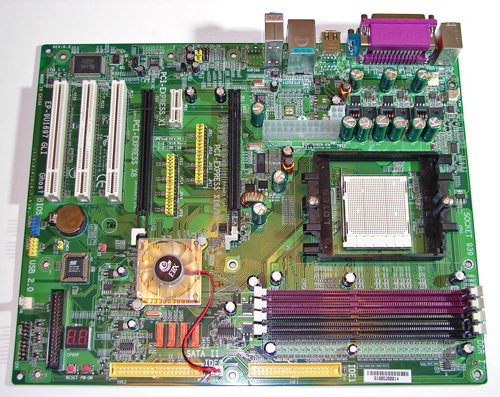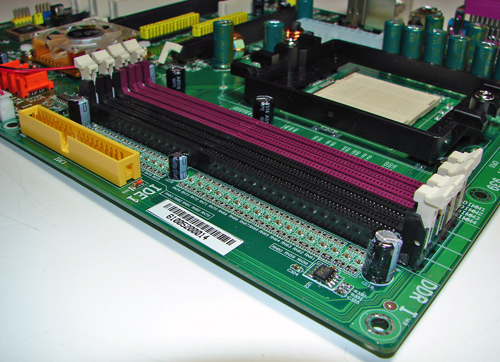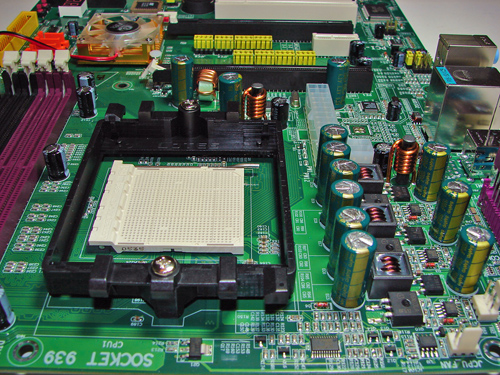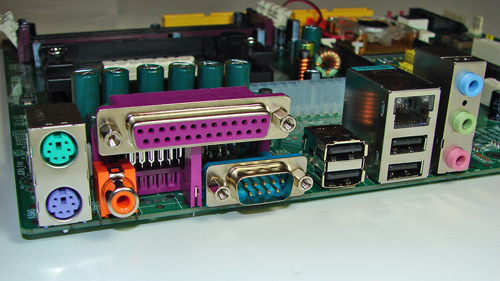EPoX EP-9U1697-GLi: ULi M1697 Goes Mainstream
by Gary Key on March 15, 2006 12:05 AM EST- Posted in
- Motherboards
EPoX EP-9U1697 GLi: Features
The chipset fan header is located below the ULi SATA ports. The ULi M1697 chipset is actively cooled with a fan and low rise heat sink that did not interfere with cards installed into a secondary PCI Express x16 slot. The fan was generally quiet during operation, although we believe that a well-designed passive heat sink could have been utilized on this board.
The CP80P post port debug LED along with the power on and reset buttons are located to the left of the IDE and SATA connectors and right of the floppy drive connector. The floppy driver connector is located in an unusual position, and if utilized the cabling could interfere with the SATA and IDE ports. The ULi USB connectors, chassis panel, and system fan header are located on the left edge of the board. The yellow CMOS jumper block is a traditional jumper design located to the left of the BIOS chip and below the battery.
The first physical PCI Express x16 connector is located below the 24-pin ATX power connector. The configuration jumpers and the PCI Express x1 connector are located next. The additional slot space in this area easily accommodated our dual slot video cards and still allowed the PCI Express x1 connector to be utilized. The second physical PCI Express x16 connector is located next, followed by the three 32-bit PCI 2.3 slots.
We did not have any issues installing our EVGA 7800GTX 512MB or ATI X1900XTX video cards in the second x16 PCI Express slot. Of course, these dual slot cards will physically render the first 32-bit PCI slot useless. We did not have any issues utilizing the first PCI slot with video cards containing single-slot cooling systems.



The chipset fan header is located below the ULi SATA ports. The ULi M1697 chipset is actively cooled with a fan and low rise heat sink that did not interfere with cards installed into a secondary PCI Express x16 slot. The fan was generally quiet during operation, although we believe that a well-designed passive heat sink could have been utilized on this board.
The CP80P post port debug LED along with the power on and reset buttons are located to the left of the IDE and SATA connectors and right of the floppy drive connector. The floppy driver connector is located in an unusual position, and if utilized the cabling could interfere with the SATA and IDE ports. The ULi USB connectors, chassis panel, and system fan header are located on the left edge of the board. The yellow CMOS jumper block is a traditional jumper design located to the left of the BIOS chip and below the battery.

The first physical PCI Express x16 connector is located below the 24-pin ATX power connector. The configuration jumpers and the PCI Express x1 connector are located next. The additional slot space in this area easily accommodated our dual slot video cards and still allowed the PCI Express x1 connector to be utilized. The second physical PCI Express x16 connector is located next, followed by the three 32-bit PCI 2.3 slots.
We did not have any issues installing our EVGA 7800GTX 512MB or ATI X1900XTX video cards in the second x16 PCI Express slot. Of course, these dual slot cards will physically render the first 32-bit PCI slot useless. We did not have any issues utilizing the first PCI slot with video cards containing single-slot cooling systems.













35 Comments
View All Comments
Palek - Wednesday, March 15, 2006 - link
Gary,There is a spelling error in the last sentence of the 1st page:
"Let's find out how Epox's offering fairs against the competition."
The correct spelling is "fares" not "fairs".
Gary Key - Wednesday, March 15, 2006 - link
I had corrected it on the final draft and somehow it still made it in. My fault for not catching it once the article went live last night. It is corrected now as are the ascending chart figures.Googer - Wednesday, March 15, 2006 - link
Is epox part of Shuttle?http://local.google.com/local?q=Epox%20EP-9U1697-G...">http://local.google.com/local?q=Epox%20...utf-8&am...
Googer - Wednesday, March 15, 2006 - link
The ULi M1695 is all about upgradeability and the ASrock implementation uses a 20pin PSU where as the Epox implementation needs a 24pin connection. Based on the benchmarks it also looks like you will need to purchase a PCI-e x1 gigabit controller.Speaking from experience, my biggest gripe on the ASrock M1695 is the BIOS is very quirky and can be very very slow to POST.
Epox is the king if you are an overclocker and overall performance is very impressive compaired to the ASrock ULi M1695.
Avalon - Wednesday, March 15, 2006 - link
8Mb throughput? Are you sure that's not a mistake?The only comment on Epox's ethernet score was that it was not competitive...700Mb vs 8Mb...I'd say something is wrong, or a typo?
Palek - Wednesday, March 15, 2006 - link
Yeah, I noticed that, too, then I found the missing "9" outside the graph area. The figure is correct, it's just the layout that is messed up.Gary Key - Wednesday, March 15, 2006 - link
The actual number is 98.9Mb/s. Our graph engine has a small issue with variances that wide. It placed the 9 into the description field. I updated the text statement to reflect this issue. Thank you.Peter - Friday, March 17, 2006 - link
While you're updating, you might want to correct the research error that the RTL8201 is a "PCI based solution". It is not, it's just a PHY to the ULi chip's integrated 10/100 MAC.Oh, and when are you finally going to stop attributing memory performance to chipsets on AMD64?
Cygni - Wednesday, March 15, 2006 - link
Might have to pick one of these up...Rock Hydra - Wednesday, March 15, 2006 - link
The Epox EP-9U1697 GLi displayed superb stability with 4 DDR2 modules in Dual-Channel operation at the settings of 2-2-2-7, but it required the command rate to be increased to 2T.